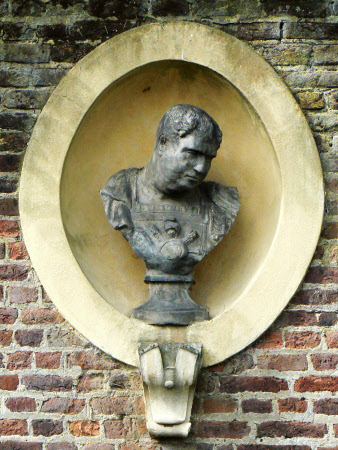Bust of the Roman emperor Aulus Vitellius
workshop of John Besnier (fl.1681)
Category
Art / Sculpture
Date
c. 1670 - 1672
Materials
Lead, Sandstone
Measurements
735 mm (H)475 mm (W)
Place of origin
London
Order this imageCollection
Ham House, Surrey
NT 1140366
Summary
A lead portrait bust of a Roman emperor wearing armour, his corselet embellished with a trophy of arms. Probably identifiable as the emperor Aulus Vitellius (A.D. 14-69). One of thirty-eight lead busts made for the garden walls of Ham House in 1671-72, perhaps in the workshop of John Besnier, thirty-six of which survive in niches on the walls and on the north façade of the house.
Full description
A lead portrait bust of the Roman emperor Aulus Vitellius (A.D. 14-69) as a general, wearing a square-necked corselet, straps and a cloak at shoulders. The corselet is decorated with a trophy of arms, with a round shield, behind mounted on a staff a phrygian cap, and crossed fasces (bundle of rods with a projecting axe blade, a Roman symbol of power), A thickset burly face, he looks downwards and to his left. Mounted on a plinth, and placed on a sandstone console carved with a bifurcated strap. Aulus Vitellius is said to have led a debauched life when young, befriending Tiberius and subsequently the young Caligula. After a political career, Vitellius was chosen to lead the Roman army on the Rhine, making himself popular with the troops, who soon declared him Emperor, as did other armies in western Europe. Although Vitellius was received as emperor in Rome, his reign lasted only eight months, before he was defeated by the armies of Vespasian and brutally murdered. According to Suetonius and other early biographers, Vitellius was given to gluttony and other vices, which helps to explain why in many portraits he is shown as fleshy and obese. In this portrait, the face and head, with its pronounced turn to his left, is based on the Grimani Vitellius, a celebrated marble portrait said to have been discovered in Rome in 1505 and bequeathed to the Republic of Venice by Cardinal Domenico Grimani in 1523. The Grimani Vitellius was much admired and copied from an early date. A plaster bust of Vitellius on the staircase at Ham House (NT 1139677) also combines the a head based on the Grimani Vitellius with a different bust section. The present bust is is one of two of the same model at Ham (the other is NT 1140337) and it presumably originally formed part of a sequence of the Twelve Caesars. One of thirty-six lead busts displayed in oval niches in the garden walls and on the north façade of Ham House, probably installed in 1671-72, and recorded in the 1679 inventory of Ham House. The entire series was probably arranged in its present positions along the garden walls and on the north front of Ham House by the 6th Earl of Dysart, as part of improvements undertaken between 1798 and 1803. The busts may well, like other sculpture at Ham House, have been made in the workshops of the Besnier family, perhaps by John Besnier, who received a commission for lead statuary from the Duke of Ormonde in 1681. For a fuller discussion of the garden wall busts and their history and attribution, see NT 1140333. Jeremy Warren January 2022
Provenance
Probably made and installed in 1671-72, to the commission of John Maitland and Elizabeth Murray, 1st Duke and Duchess of Lauderdale. Thence by descent,until acquired in 1948 by HM Government when Sir Lyonel, 4th Bt (1854 – 1952) and Sir Cecil Tollemache, 5th Bt (1886 – 1969) presented Ham House to the National Trust. Entrusted to the care of the Victoria & Albert Museum until 1990, when returned to the care of the National Trust, to which ownership was transferred in 2002.
Makers and roles
workshop of John Besnier (fl.1681), sculptor
References
Avery 2013: Charles Avery, ‘Seventeenth-century Sculpture at Ham House’ in Christopher Rowell, ed., Ham House. 400 Years of History, New Haven/London 2013, pp. 158-77.



